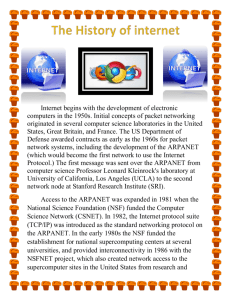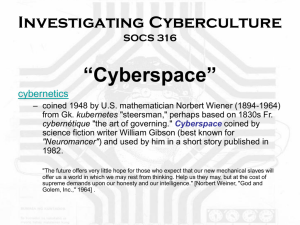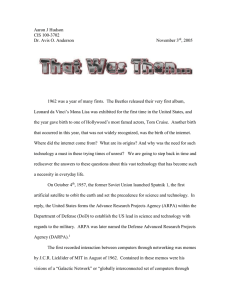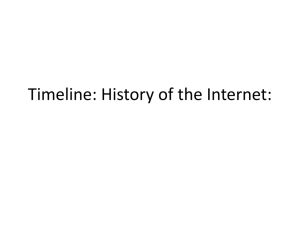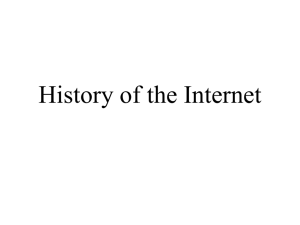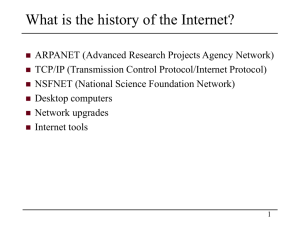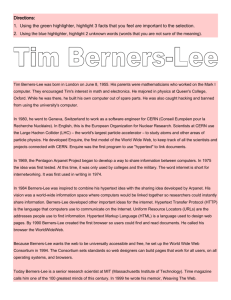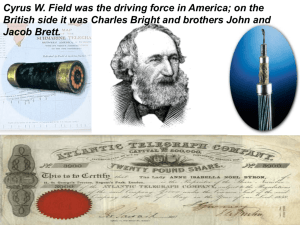History of the Internet and WWW PowerPoint Notes
advertisement
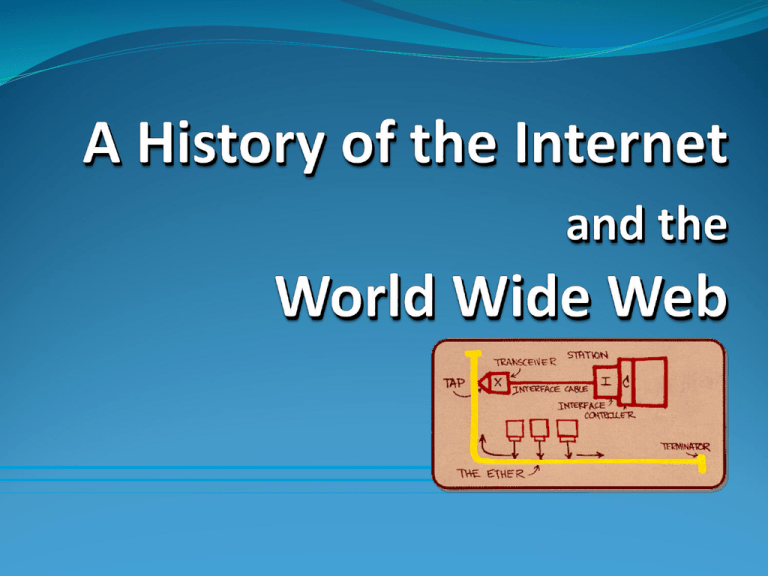
The Atlantic Cable: The Atlantic cable laid in 1858. Designed to carry instantaneous communications across the ocean for the first time. It was a technical failure. It only remained in service a few days. Subsequent cables laid in 1866 were completely successful Compare to events like the moon landing of a century later The cable remained in use for almost 100 years. History of the Internet Sputnik 1 launched on Oct. 4, 1957 President Eisenhower became concerned that the Soviets would advance faster than the United States in Technology. History of the Internet Eisenhower approved the creation of the Advanced Research Projects Agency (ARPA) by the Defense Department in 1958. The agency was a "think-tank" of scientist and engineers. This agency crafted the United States' first successful satellite in 18 months. History of the Internet In 1961, the Director of Defense Research and Engineering (DDR&E) assigns a Command and Control Project to ARPA. In 1962, the Information Processing Techniques Office (IPTO) formed to coordinate ARPA's command and control research. History of the Internet J.C.R. Licklider (1915-1990), at MIT, was made the head of the Information Processing Techniques Office (IPTO). IPTO’s mission was to research methods for improving the military's use of computer technology at the Advanced Research Projects Agency (ARPA). History of the Internet Licklider developed the concept of a network for social interactions via computer in 1962. His "Galactic Network" envisioned a globally interconnected set of computers through which people could quickly access data and programs from any site. He also pushed to have ARPA's contracts moved from the private sector to universities. The Beginning of the ARPANET In 1966, Robert Taylor, Licklider’s replacement, suggested that existing machines could be used to link sites. Taylor bullied Larry Roberts into coming to APRA and networking these machines. Larry Roberts sometimes referred to as the “father of the Arpanet.” The Beginning of the ARPANET A problem was computers needed to networked did not all use the same operating system. Roberts designed a smaller computer for each facility to link the primary machines at each location. These were called IMPs (Internet Message Processors). History of the Internet Dr. Leonard Kleinrock develops the principle of transmitting data as “packets” of data rather than a continuous stream. He published his first paper on the subject in 1961. History of the Internet In 1969, ARPA awards a contract to the Bolt, Baranek and Knewman Corporation to develop a IMP (Interface Message Processor). This device breaks data streams into the "packets" of information. An IMP allows data from more than one source to be transmitted over the same transmission line. This makes the internet possible. The internet is referred to as a “packet-switching” network. History of the Internet Kleinrock, now at UCLA, is responsible for the setup an ARPANET in 1969. The Day the Infant Internet uttered its First Words took place at 22:30 hours on October 29, 1969. The message transmission was to go from the UCLA to Stanford Research Institute (SRI). History of the Internet The first planned message to be transmitted over ARPANET was the word "login" Charley Kline at UCLA sent the first packets on ARPANet as he tried to connect to Stanford Research Institute on Oct 29, 1969 They succeeded in transmitting the "l" and the "o" and then the system crashed! About an hour later, they were able to send the entire word. History of the Internet A view of the record of the first internet transmission. History of the Internet Initially Arpanet was connected four major computers at universities in the southwestern US (UCLA, Stanford Research Institute, UCSB, and the University of Utah). The contract was carried out by BBN of Cambridge, MA under Bob Kahn and went online in December 1969. By June 1970, MIT, Harvard, BBN, and Systems Development Corp (SDC) in Santa Monica, Cal. were added. By January 1971, Stanford, MIT's Lincoln Labs, CarnegieMellon, and Case-Western Reserve U were added. In months to come, NASA/Ames, Mitre, Burroughs, RAND, and the U of Illinois plugged in. History of the Internet Initial ARPANET Diagram History of the Internet The logic layout of ARPANET by 1971 History of the Internet In a short time and the network grew to 107 institutions. In 1972 the first public demonstration of the ARPANET took place at the International Conference on Computer Communications. The ARPANET eventually split into two systems, ARPANET for university use and MILnet, for military use. ARPA became DARPA (Defense Advanced Research). History of the Internet Robert Kahn introduced the concept of an open-architecture network in 1972. Open architecture networks allows individual networks to communicate with each other regardless of their configuration. History of the Internet NCP had difficulties addressing systems further down-stream from the network. Robert Kahn and Vint Cerf developed a protocol called the Transmission Control Protocol/Internet Protocol (TCP/IP). The fourth version of this protocol is now the standard used by all networks to move data from one place to another. History of the Internet NSFNet was placed in operation in 1985. Sponsored by the National Science Foundation, it provided a more advanced network backbone that used high-speed computing on a supercomputer. History of the Internet ARPANET is shut down in 1989 because it could not compete with NSFNet in speed and performance. This was the primary network used by colleges and university at the time. (NSFNet no long is in operation.) History of the World Wide Web In 1945, Vannevar Bush (Science Advisor to president Roosevelt during WW2) proposes Memex. Memex is conceptual machine that can store vast amounts of information, in which users have the ability to create information trails, links of related texts and illustrations, which can be stored and used for future reference. History of the World Wide Web In his view, Memex would act like the human mind which uses an “association of thoughts, in accordance with some intricate web of trails carried by the cells of the brain. ” Vannevar Bush History of the World Wide Web Theodore Nelson coins the term Hypertext, Hypermedia and World Wide Web. Ted Nelson is also know for conceptualization of "Xanadu," a central, pay-per-document hypertext database encompassing all written information, which has never gotten off the ground. History of the World Wide Web The first working hypertext system was developed at Brown University in 1967, by a team led by Andries van Dam. The Hypertext Editing System ran in 128K memory on an IBM/360 mainframe and was funded by IBM, who later sold it to the Houston Manned Spacecraft Center, where it was used to produce documentation for the Apollo space program. History of the World Wide Web In 1990, Robert Cailliau and Tim Berners-Lee at CERN develop hypertext in order to allow scientist working in particle physics to exchange information and distribution of information over the Web begins. History of the World Wide Web In 1992, develops Graphical CERN the first Browser. History of the World Wide Web The computer used for the development of Hypertext was a NeXT Internet machine developed by Steve Jobs, one of the founders of Apple Computers. Jobs was asked to return to Apple Computers in 1997 and the NeXT operating system is the basis of the current Mac OS. History of the World Wide Web In 1991, the Stanford Linear Accelerator Center in California becomes the first Web server in the USA. History of the World Wide Web In 1993, Mosaic is released by the National Center for Supercomputing Applications (NASA) at the University of Illinois. This graphical browser was developed by Marc Andreessen, a college student and part-time employee of NASA. History of the World Wide Web In 1994, Marc Andreeseen leaves NASA to set up his own company, Mosaic Communications Corp. (now Netscape Corp.) and hires all of the developers of Mosaic away from NASA. History of the World Wide Web 1994, the first International WWW (W3C) Conference is held. Later the same year, the WWW Conference Committee is formed. References: History of the Internet: Chapter 1 by Gregory Gromov http://www.netvalley.com/cgi-bin/intval/net_history.pl — History of the Internet: Chapter 2 by Gregory Gromov — http://www.netvalley.com/cgi-bin/intval/net_history.pl?chapter=2 How it Really Happened by Robert Cailliau — http://www.computer.org/internet/v2n1/cailliau.htm Leonard Kleinrock's Personal History/Biography The Birth of the Internet – http://www.lk.cs.ucla.edu/LK/Inet/birth.html The Real History of the Internet by Christopher D. Hunter — http://www.asc.upenn.edu/usr/chunter/agora_uses/chapter_2.html
